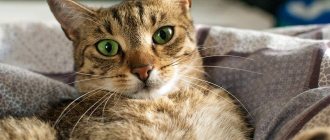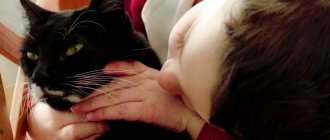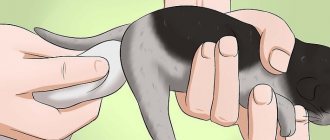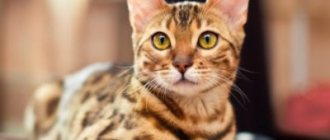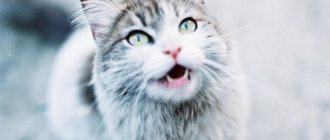Insecticides are dangerous to animal health. Therefore, when treating a cat with flea drops, there is a risk of poisoning. This is especially true for those owners who have several pets. After all, cats often lick each other and can accidentally swallow medicine.
Let's find out what measures need to be taken to save animals in case of insecticide poisoning and whether it is possible to do without calling a veterinarian.
Causes of poisoning with flea drops
Most often, veterinarians indicate the following causes of poisoning in cats:
- Incorrect application of the product, namely smearing and rubbing concentrated solutions of insectoacaricides on parts of the cat’s body that are accessible to licking (belly, ears, inner thighs, tail root). The correct application of drops is pointwise in 1-2 zones along the spinal column, without rubbing. The drug spreads well and penetrates into the subcutaneous fat and hair follicles, from there it affects the tick and flea upon contact or bite.
- Treatment of weakened and sick animals, which is a complete contraindication for such manipulations. Since a small part of the active substances in flea drops still penetrates the bloodstream, a toxic effect on the cat’s liver and kidneys cannot be ruled out.
- Exceeding the dosage most often occurs when determining the pet’s weight “by eye”. Double or higher concentrations of the drug are considered dangerous. Therefore, animals need to be weighed periodically.
- The cat was washed a day after treatment, and she licked off the remaining flea drops. Poisoning occurs due to the fact that the flea remedy, which is not absorbed, is washed out over the entire surface of the cat’s fur, from where she licks it off.
- Use of canine products. Many drugs that are intended for dogs and cats are produced under the same name, but they often have different compositions. Due to cats' intolerance to certain insecticides, to which dogs do not have a similar reaction, severe poisoning may develop, even leading to death. Therefore, it is unacceptable to buy one product for different types of animals. If you need to save money, you should study the instructions for the drugs or check the name with your veterinarian.
- Handling kittens that are breastfed can be dangerous for the mother cat, as her constant licking of her babies may cause her to ingest chemicals from their fur.
- Individual intolerance to certain substances, which is typical for cats of decorative breeds. It is worth checking with the breeder about this when purchasing purebred kittens.
How to treat a kitten after poisoning
After completing first aid measures at home, you can carry out therapeutic measures.
- Three hours after giving enveloping substances and adsorbents, give a laxative: one teaspoon of vegetable oil, saline laxatives (sodium or magnesium sulfate 2% solution 1–5 ml).
- An enema cleanses the intestines well: inject 5–10 ml of saline solution into the kitten’s rectum from a syringe.
- To enhance kidney function, give a diuretic, preferably of plant origin: decoctions of bearberry, lingonberry, juniper berries, a diuretic mixture.
- If dehydration occurs, give saline or Ringer's solution.
- To maintain the body, a glucose solution is given.
- For liver function. When a kitten is poisoned, how to treat the liver so as not to harm it? You can give Karsil 1/4 tablet, Hepatovet 0.5 ml for a month - this will support the body well.
Remember, in case of poisoning, it is important to provide first aid as quickly as possible. The success of further treatment will depend on this. Stop the absorption of the poison, and then seek qualified veterinary care.
source
Poisoning with FOS substances and carbamates
Organophosphates (diazinon, tetrachlorvinphos) and carbamates (propoxur) are considered obsolete and toxic agents for the control of insects and ticks in cats.
Since 2004, they have been used mainly in agriculture. However, some modern pharmaceutical companies continue to produce cat drops and flea collars with these substances due to their proven effectiveness and good sales.
Examples:
- flea drops “Flea Drops” from Beaphar with the active ingredient diazinon (which are no longer sold in Russia, but are available in other countries);
- insecticidal drops “Best friend Ectostop” on diazinon;
- anti-parasite collars from Hartz (tetrachlorvinphos).
Several years ago in the Russian Federation, the drug “Dana” was produced with diazinon, but today the API-SAN company has changed the composition of flea drops (fipronil + auxiliary components).
Carbamates (propoxur) are present in some flea collars for cats from the Bolfo brand, and poisoning can occur if the cat licks or chews the accessory.
Clinical symptoms
If it happens that the cat licked the flea drops with diazinon, then clinically this is expressed by the following signs:
- excessive salivation from the mouth (a characteristic sign);
- lethargy, apathy;
- frequent urge to vomit (expressed as smacking and licking);
- loose stools;
- complete lack of appetite;
- muscle weakness and convulsive manifestations;
- rapid or, conversely, weakened heartbeat (depending on the dose);
- shortness of breath, rapid breathing with an open mouth;
- constant “small” trips and thirst.
A local allergic reaction is expressed in redness of the area where drops are applied, development of irritation, itching, and scratching.
Treatment
In such cases, the first thing to do is to prevent further absorption of toxins from the skin by washing off the product using a cleansing shampoo with a strong degreasing effect.
Next, it is recommended to rinse the cat’s mouth and stomach and induce vomiting by injecting a large amount of water. After washing, sorbents (activated carbon, Smecta, Enterosgel) are introduced.
If convulsions or muscle tremors appear, you should immediately take the cat to the veterinarian, he will administer intravenous anticonvulsants to reduce agitation and other necessary drugs (Atropine, Diazepam), prescribe infusion therapy and a therapeutic diet.
Treatment components
Treatment is prescribed by a veterinarian after examining the pet. Show the doctor the drug you treated him with. You also need to tell about your animal’s concomitant diseases, whether he is allergic to medications or food components.
After examining the pet, the doctor will begin providing first aid. It may consist of:
- intravenous or intramuscular administration of steroids. The most commonly used drug is dexamethasone. This drug quickly eliminates allergic manifestations and improves the pet’s condition;
- droppers with solutions to reduce intoxication and accelerate the removal of toxins from the body through the kidneys;
- administration of antihistamines (antiallergic) drugs, this can be diphenhydramine, suprastin, loratadine.
After providing first aid, the doctor will prescribe a course of treatment. You can give some medications to your animal yourself. For injections and IVs, you will need to bring your animal to the veterinary clinic.
Poisoning with pyrethrins and pyrethroids
Pyrethrins are insecticides of plant origin, which are obtained from certain types of plants (Dalmatian chamomile, chrysanthemum, tansy). In veterinary medicine, permethrin is actively used for cats (at 0.5-1% concentration in anti-flea shampoos, collars, drops, but in other proportions it is considered poison).
This is explained by the fact that in a cat’s body, permethrin does not break down into harmless compounds (as it does in dogs) and exhibits a toxic effect on the nervous system, which leads to prolonged convulsions and death.
This is why owners should be aware that permethrin dog drops should not be used on cats, as it can kill them.
Attention! If a cat licks flea drops containing permethrin applied to a dog upon contact, this will also cause poisoning. If a cat and a dog live together in the house, then it is better to buy insectoacaricidal products with other components.
Examples of existing products for cats with permethrin (their use is permissible only if the instructions are strictly followed):
- drops on the withers “Clandestine for cats” (1% permethrin);
- “Clandestine” universal powder (0.4% permethrin);
- spray "Clandestine" for cats and dogs (0.35% permethrin);
- anti-parasitic shampoos of the “Clandestine” brand (0.4% permethrin);
- anti-flea collars “Clandestine maximum” for cats (1% permethrin);
- “Pchelodar” – universal shampoo against fleas and ticks (0.25% permethrin);
- insecticidal shampoo for cats and dogs “Fitoelita” (0.3% permethrin);
- flea shampoo “Lapushka” (0.4% permethrin).
Pyrethroids are synthetic analogues of pyrethrins. Deltamethrin and etofenprox are used for domestic cats. Examples of drugs:
- Lugovoy shampoo for cats and dogs (deltamethrin 0.01%);
- drops for fleas in cats brand “Rolf Club 3D” (etofenprox 15%);
- butox 50 concentrate for preparing a solution (deltamethrin 5%).
Recently, due to frequent cases of poisoning in cats by these substances, many manufacturers of veterinary insecticides are discontinuing the production of certain drugs or replacing the formulation.
Symptoms
So, what happens if a cat licks flea drops that contain pyrethrins and pyrethroids:
- Half of the cats experience overexcitation, which is expressed in prolonged convulsions and twitching of the limbs;
- trembling;
- saliva is produced profusely;
- there is a loss of orientation in space;
- body temperature rises;
- pupils dilate;
- temporary hypersensitivity appears;
- coordination of movements is impaired;
- heart rate increases;
- gagging is observed;
- lethargic sleep may occur.
Therapy
Pyrethrins have no antidotes, so treatment is aimed at removing toxins from the cat's body.
If the poison has entered the digestive system, then you need to start with the administration of emetics or gastric lavage. At home, you should pour warm water into the cat’s mouth to induce vomiting, then give adsorbents (Smecta, Enterosgel).
If pyrethroids are ingested externally in a toxic dose (when treating a cat with dog drops), you need to wash the animal several times with regular shampoo and then feed it with adsorbents.
If a cat has licked off flea drops and has convulsive reactions, you should immediately go to the veterinarian, he will provide first aid, prescribe appropriate treatment, or leave the animal in a hospital under his supervision.
As a rule, cats recover in 3-5 days if first aid is provided to them in a timely and competent manner.
What to do in case of poisoning
Treatment of poisoning with flea drops is carried out by a veterinarian. When the first signs of disease appear, you should take your pet to a veterinary hospital. If for some reason you cannot do this right away, for example, if symptoms develop at night and there is no 24-hour hospital nearby, begin to provide first aid yourself. Below we looked at its main components:
- Give your pet the sorbent to drink. Regular activated carbon will do. Calculating the dosage is very simple: for 10 kg of animal weight you need to take 1 tablet of coal. So for a cat weighing 5 kg you will need half a tablet. The medicine must be dissolved in 5-10 ml of plain water and administered into the animal’s mouth through a syringe (without a needle).
- Give your pet plain water. This is best done with a syringe. Pour 5-10 ml of liquid into the animal's mouth every 10 minutes. Drinking will help reduce the severity of intoxication syndrome.
There is nothing more you can do to help the animal. There is no need for an enema or gastric lavage, since most of the drug is absorbed into the body through the skin. Further treatment will be carried out in a veterinary clinic.
Poisoning with vegetable oil extracts
Some cat owners prefer to buy biological products for fleas, created on the basis of extracts of various plants (neem, mint, geranium, citronella, cloves, rosemary, tea tree, cinnamon). Such products effectively repel insects, but have virtually no effect on ticks.
Biological products are an excellent addition to classic insectoacaricides and can be the main method of protection for weakened, pregnant, lactating cats, as well as small kittens.
Examples of herbal drops on the withers:
- trademark GreenFort NEO (Ekoprom);
- a series of economical preparations Chistotel Bio (Ecoprom);
- line of VETO Pure Beaphar BIO products against fleas, ticks and mosquitoes with margosa extract;
- BIO series for cats against external parasites GAMMA;
- Good Dog Antiparasitic BIO drops;
- Natura Delix Bio Drops;
- ECO ZOOLEKAR BIO drops;
- Bio-drops AVZ “4 with a tail”;
- Drops "Rainbow BIO";
- Bio-Drops repellent Ms.Kiss;
- Flea remedy "BioVax-BIO".
However, a cat can also be poisoned by plant extracts if it ingests a large dose of the drug while licking its kittens or itself. For the first alarming symptoms to appear, a long-term interaction between the animal and the biological product is necessary (frequent treatments, a large number of kittens sprayed with the biological product, or a group of several cats that live in the same territory and lick each other).
There are pets with increased sensitivity to certain odors and extracts (congenital allergies), in which the first symptoms of poisoning may appear after a single treatment.
Typically, the problem of overdose with plant extracts is rare, and biological products have a short shelf life. Therefore, owners of city cats who take their pets out into nature try to apply drops or spray more often to avoid flea attacks.
You can also often read advice to cat owners on pet forums: “Treat your cats with biodrops every week or apply a herbal spray to their paws every day before walking outside.” Such advice contradicts the instructions for biological products, which leads to poisoning with plant extracts.
Signs of poisoning
If a cat manages to ingest plant drops against fleas, then after 30-50 minutes the following symptoms of poisoning will appear:
- excessive salivation (hypersalivation);
- refusal to eat for a day or more;
- lacrimation;
- vomit;
- muscle contractions, tremors;
- decreased body temperature (below 37.5);
- lethargy and apathy.
Deaths are quite rare with such poisonings, but are not excluded with prolonged low body temperature and decreased blood pressure.
Treatment methods
Treatment consists of eliminating severe symptoms and removing any remaining product from the cat’s fur. Namely:
- gastric lavage, stimulation of vomiting (pour in liquid, press on the root of the tongue with a spoon);
- soldering of adsorbents (activated carbon, Smecta, Enterosgel);
- drip infusion of nutrient solutions into a vein to prevent dehydration;
- for muscle twitching, Diazepam (a sedative) is administered;
- bathing in soapy water using a cleansing shampoo (to wash the drug off the skin and coat).
With this treatment, the animal will recover within 1-2 days.
Important! If a cat has an unusual reaction to a biological product, it is worth studying its composition and not buying analogues in the future.
What to do?
Veterinarians unanimously insist that under no circumstances should you try to treat cats with medications intended for humans. First of all, you will need a medical consultation.
At home, owners can use Activated Carbon to help their pet.
If the cat licked droplets of the product for less than 10 minutes. back, then you need to quickly trigger a gag reflex in your pet by pressing on the root of the tongue. From folk recipes, a decoction of rice boiled over low heat for ¾ hours is recommended. Before use, the medicinal product is filtered and cooled to room temperature. The liquid can be poured into a bowl as an alternative to regular water. In the next 2-4 days after the incident, the pet should eat dietary food - cereals, milk and homemade yogurt. Meat and fish are excluded.
Toxicity of fipronil and imidacloprid
Today, the pet market is replete with an abundance of anti-flea products for pets, and more than half of all drugs contain the popular substance fipronil in their formulation.
Here are the most popular names of flea drops for cats on fipronil with different price categories:
- Bars and Bars forte;
- Frontline and Frontline Combo;
- Rolf Club 3D;
- Inspector;
- Dana ultra;
- Fiprist;
- Celandine Maximum;
- Insectal;
- Flea No Max;
- Miss Keys;
- Fiprotek.
Fipronil has been used in veterinary medicine for many years to treat domestic animals against external parasites. Scientists have already proven that a small part of fipronil applied to the skin is metabolized in the liver. And if drops based on fipronil are used monthly for several years, then intoxication of the body occurs and a clinical picture of poisoning develops (experiments were conducted on laboratory rodents).
It was precisely this problem that dog breeders were the first to face, regularly purchasing expensive imported and domestic drugs in which fipronil is the main component. In cats, this picture is also possible.
Advice! With regular insectoacaricidal treatments, the drug should be changed annually to another one (with a different composition). This will help prevent the development of fipronil poisoning, which accumulates in the cat's body.
Imidacloprid is another popular remedy that is included in flea drops. It is used mainly in imported drugs (Advocate and Advantage from Bayer). Kills fleas but has no effect on ticks.
It is considered a fairly safe substance for animals, however, in combination with other chemicals (when a collar of the same composition is put on a cat, drops with other substances are applied to the withers), a toxic reaction is likely to develop, even if the cat did not lick the drug.
If the owner claims that his cat was poisoned by flea drops that contain imidacloprid, then the following factors may be the reasons:
- individual intolerance, which is difficult to predict in advance, but can be identified after the fact of poisoning;
- overdose by 2-3 times (when the weight of the animal is determined “by eye” or the kitten is treated);
- simultaneous use of several flea products (drops, collars, sprays) with different compositions (different chemicals can enhance or inhibit each other’s actions).
What to do with a cat poisoned by imidacloprid or fipronil:
- Wash off the drops from the animal’s body with a soap solution (if no more than 3 days have passed since application).
- If the cat has drunk some drops, immediately rinse its mouth with warm water, give it something to drink and induce vomiting.
- Forcefully pour in the adsorbent drug: Smecta (0.5 sachet + 50 ml of water), Enterosgel (1 teaspoon + 30 ml of water).
- If seizures occur, immediately call a veterinarian or take the cat to the clinic, as infusion therapy will be required.
Flea treatment is a necessary procedure for cats that go outside and live in large groups. But in order to avoid poisoning by various chemicals, it is important to pay attention to the instructions for the drugs, know the exact weight of the pet and limit the use of one product.
If for some reason the drug did not work and was washed off with water, then you need to wait 2-3 weeks (so that the residual components are eliminated from the body), and only then purchase other drops after preliminary consultation with a veterinarian.
How to help your pet
Having noticed alarming symptoms, you need to try to alleviate the condition of a cat poisoned by flea drops as much as possible. Ideally, take the animal to the veterinarian and place it in the hands of a professional. However, this is not always possible, and it’s a shame to look at a cat. What to do in this case?
You can give the animal rice water. It is prepared by pouring one and a half tablespoons of cereal with half a liter of water and boiling over low heat for about forty minutes. The cooled and strained liquid is offered to the cat. Since he is constantly thirsty, most likely he will not refuse the medicine. Otherwise, the broth is poured inside the cat using a syringe.
Among medications for poisoning with flea drops, Smecta is used. Half a sachet of this drug is diluted with two tablespoons of water and poured into the mouth or offered to the animal as a drink. The danger to a cat can be significantly reduced by allowing the animal to lick half a tablet of regular activated carbon, crushed and dissolved in water.
It will draw out all toxins from the body. No-Shpa will help relieve the condition caused by the drops. The dose of this drug for an adult cat is also 0.5 tablets. But the intestinal microflora is perfectly restored by the prebiotic for animals “Vetelakt”. The specifics of its use are described in the attached instructions.
© shutterstock
A cat that has been poisoned by flea drops should drink more. You can add a little potassium permanganate to the water if the incident occurred recently. Fatty, salty, sweet foods are contraindicated for the animal during this period. Most likely, the cat himself will refuse such food, because his appetite is practically zero.
General rules of use
Typically, drops against fleas and ticks are applied to the animal's skin at the withers. To do this, you need to carefully move the fur apart and apply the dose of the drug indicated in the instructions. For better effect, the product can be rubbed into the skin. After this procedure, the kitten cannot be combed or washed for 2-3 days.
Sometimes manufacturers recommend applying droplets not only to the withers, but also along the spine. This is done in exactly the same way as in the first case. Each drug has its own dosage, so be sure to read the instructions before applying the product. It also describes in detail the number of flea drops.
Sometimes your veterinarian may recommend using a spray instead of drops. In this case, the drug must be applied differently. For example, Fipronil spray must be sprayed onto the entire skin of the animal.
Safety precautions for application
The manufacturer's recommendations indicate that the composition should be applied to the area between the shoulder blades along the spine. The cat will not be able to turn its head so as to reach the withers area.
Unfortunately, correct application does not provide a 100% guarantee of protection against droplets getting into the animal. To prevent flea treatment from causing poisoning, you should adhere to the following rules:
- do not apply drops in a long line (an area of 2 cm is sufficient);
- try to distribute the medicine closer to the hair roots;
- If there are several cats in the house, isolate them from each other during treatment.
You can try to protect especially resourceful cats by attaching a collar to the neck. It will fix the head and prevent it from reaching the areas treated with insecticide. The time for complete absorption of the drug is about 2 hours (manufacturers indicate the exact period in the annotation). After this, the remaining drops become completely safe.
